Environmental toxicant induced epigenetic transgenerational inheritance of ovarian pathology and granulosa cell epigenome and transcriptome alterations: ancestral origins of polycystic ovarian syndrome and primary ovarian insufiency
- PMID: 30207508
- PMCID: PMC6224216
- DOI: 10.1080/15592294.2018.1521223
Environmental toxicant induced epigenetic transgenerational inheritance of ovarian pathology and granulosa cell epigenome and transcriptome alterations: ancestral origins of polycystic ovarian syndrome and primary ovarian insufiency
Abstract
Two of the most prevalent ovarian diseases affecting women's fertility and health are Primary Ovarian Insufficiency (POI) and Polycystic Ovarian Syndrome (PCOS). Previous studies have shown that exposure to a number of environmental toxicants can promote the epigenetic transgenerational inheritance of ovarian disease. In the current study, transgenerational changes to the transcriptome and epigenome of ovarian granulosa cells are characterized in F3 generation rats after ancestral vinclozolin or DDT exposures. In purified granulosa cells from 20-day-old F3 generation females, 164 differentially methylated regions (DMRs) (P < 1 x 10-6) were found in the F3 generation vinclozolin lineage and 293 DMRs (P < 1 x 10-6) in the DDT lineage, compared to controls. Long noncoding RNAs (lncRNAs) and small noncoding RNAs (sncRNAs) were found to be differentially expressed in both the vinclozolin and DDT lineage granulosa cells. There were 492 sncRNAs (P < 1 x 10-4) in the vinclozolin lineage and 1,085 sncRNAs (P < 1 x 10-4) in the DDT lineage. There were 123 lncRNAs and 51 lncRNAs in the vinclozolin and DDT lineages, respectively (P < 1 x 10-4). Differentially expressed mRNAs were also found in the vinclozolin lineage (174 mRNAs at P < 1 x 10-4) and the DDT lineage (212 mRNAs at P < 1 x 10-4) granulosa cells. Comparisons with known ovarian disease associated genes were made. These transgenerational epigenetic changes appear to contribute to the dysregulation of the ovary and disease susceptibility that can occur in later life. Observations suggest that ancestral exposure to toxicants is a risk factor that must be considered in the molecular etiology of ovarian disease.
Keywords: DNA methylation; Ovary; PCO disease; POI; epigenetic; granulosa; ncRNA; sperm; transcriptome; transgenerational.
Figures

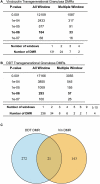

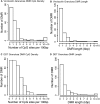
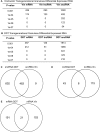

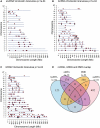

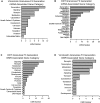
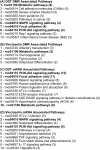

Similar articles
-
Epigenetic transgenerational inheritance of parent-of-origin allelic transmission of outcross pathology and sperm epimutations.Dev Biol. 2020 Feb 1;458(1):106-119. doi: 10.1016/j.ydbio.2019.10.030. Epub 2019 Nov 1. Dev Biol. 2020. PMID: 31682807 Free PMC article.
-
Developmental origins of transgenerational sperm histone retention following ancestral exposures.Dev Biol. 2020 Sep 1;465(1):31-45. doi: 10.1016/j.ydbio.2020.06.008. Epub 2020 Jul 3. Dev Biol. 2020. PMID: 32628935 Free PMC article.
-
Epigenetic transgenerational inheritance of testis pathology and Sertoli cell epimutations: generational origins of male infertility.Environ Epigenet. 2019 Aug 29;5(3):dvz013. doi: 10.1093/eep/dvz013. eCollection 2019 Jul. Environ Epigenet. 2019. PMID: 31528361 Free PMC article.
-
Long non-coding RNAs in ovarian granulosa cells.J Ovarian Res. 2020 Jun 5;13(1):63. doi: 10.1186/s13048-020-00663-2. J Ovarian Res. 2020. PMID: 32503679 Free PMC article. Review.
-
Inducers and Inhibitors of Pyroptotic Death of Granulosa Cells in Models of Premature Ovarian Insufficiency and Polycystic Ovary Syndrome.Reprod Sci. 2024 Oct;31(10):2972-2992. doi: 10.1007/s43032-024-01643-3. Epub 2024 Jul 18. Reprod Sci. 2024. PMID: 39026050 Free PMC article. Review.
Cited by
-
Individualized responses to acupuncture in premature ovarian insufficiency: A study protocol for a nested case-control trial with transcriptome analysis.Heliyon. 2024 Sep 12;10(18):e37859. doi: 10.1016/j.heliyon.2024.e37859. eCollection 2024 Sep 30. Heliyon. 2024. PMID: 39328559 Free PMC article.
-
Role of epigenetic transgenerational inheritance in generational toxicology.Environ Epigenet. 2022 Feb 16;8(1):dvac001. doi: 10.1093/eep/dvac001. eCollection 2022. Environ Epigenet. 2022. PMID: 35186326 Free PMC article. Review.
-
Compound heterozygous null mutations of NOBOX in sisters with delayed puberty and primary amenorrhea.Mol Genet Genomic Med. 2021 Oct;9(10):e1776. doi: 10.1002/mgg3.1776. Epub 2021 Sep 4. Mol Genet Genomic Med. 2021. PMID: 34480423 Free PMC article.
-
Adverse Effects of Pesticides on the Ovary: Evidence from Epidemiological and Toxicological Studies.Environ Health (Wash). 2025 Mar 22;3(6):575-595. doi: 10.1021/envhealth.4c00243. eCollection 2025 Jun 20. Environ Health (Wash). 2025. PMID: 40567266 Free PMC article. Review.
-
CD24: a marker of granulosa cell subpopulation and a mediator of ovulation.Cell Death Dis. 2019 Oct 17;10(11):791. doi: 10.1038/s41419-019-1995-1. Cell Death Dis. 2019. PMID: 31624236 Free PMC article.
References
-
- Maclaran K, Panay N.. Premature ovarian failure. J Fam Plann Reprod Health Care. 2011;37(1):35–42. - PubMed
-
- Luborsky JL, Meyer P, Sowers MF, et al. Premature menopause in a multi-ethnic population study of the menopause transition. Hum Reprod. 2003;18(1):199–206. - PubMed
-
- Azziz R, Woods KS, Reyna R, et al. The prevalence and features of the polycystic ovary syndrome in an unselected population. J Clin Endocrinol Metab. 2004;89(6):2745–2749. - PubMed
-
- March WA, Moore VM, Willson KJ, et al. The prevalence of polycystic ovary syndrome in a community sample assessed under contrasting diagnostic criteria. Hum Reprod. 2010;25(2):544–551. - PubMed
Publication types
MeSH terms
Substances
Grants and funding
LinkOut - more resources
Full Text Sources
Other Literature Sources
Medical
Miscellaneous
